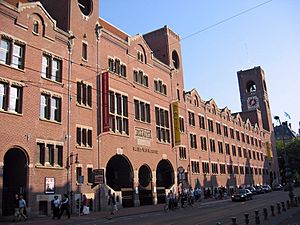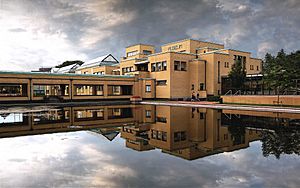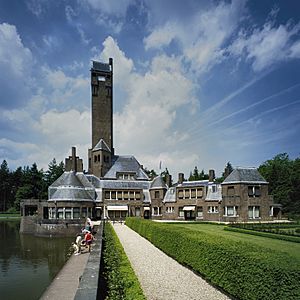H. P. Berlage facts for kids
Quick facts for kids
H. P. Berlage
|
|
|---|---|
 |
|
| Born |
Hendrik Petrus Berlage
21 February 1856 Amsterdam, Netherlands
|
| Died | 12 August 1934 (aged 78) The Hague, Netherlands
|
| Alma mater | ETH Zurich |
| Occupation | Architect |
| Buildings | Beurs van Berlage (1903) Jachthuis Sint-Hubertus (1920) Kunstmuseum Den Haag (1935) |
| Projects | Plan Zuid (1915) |
Hendrik Petrus Berlage (born February 21, 1856 – died August 12, 1934) was a famous Dutch architect. He is often called one of the "fathers" of the Amsterdam School of architecture. This was a special style of building design.
Berlage's ideas greatly influenced modern architecture in the Netherlands. He helped bridge the gap between older building styles and newer, more modern ones.
Contents
Life and Work of Berlage
Early Life and Education
Hendrik Petrus Berlage was born in Amsterdam, Netherlands, on February 21, 1856. His parents were Nicolaas Willem Berlage and Anna Catharina Bosscha.
From 1875 to 1878, Berlage studied architecture. He attended the Zurich Institute of Technology in Switzerland. After his studies, he spent three years traveling across Europe. This travel helped him learn about different building styles.
Architectural Style and Influences
In the 1880s, Berlage started a partnership with Theodore Sanders in the Netherlands. They worked on many building projects together. Berlage was also a writer and joined several architectural groups.
Berlage was inspired by other architects. He liked the brick buildings of Henry Hobson Richardson. He also admired how Lluís Domènech i Montaner combined iron and brick in his designs. These ideas influenced Berlage's own work.
His design for the Amsterdam Commodities Exchange shows these influences. He also used ideas from Eugène Viollet-le-Duc. Berlage believed in using bare brick walls to support buildings. He also thought that walls were very important for shaping a building's space. These ideas became key to a Dutch building style called 'Hollandse Zakelijkheid'.
Travel to the United States
In 1911, Berlage visited the United States. This trip had a big impact on his architecture. He was very impressed by the "organic architecture" of Frank Lloyd Wright. Wright's style focused on buildings that fit naturally with their surroundings.
When Berlage returned to Europe, he gave talks about Wright's ideas. This helped spread Wright's influence in Germany and other countries.
Notable Projects and Recognition
One of Berlage's important projects outside the Netherlands was Holland House. It was built in 1916 in London, England. This building served as offices for a Dutch shipping company.
Berlage is seen as the "Father of Modern architecture" in the Netherlands. He helped connect older traditions with new modern ideas. His theories inspired many Dutch architectural groups in the 1920s. These included the Amsterdam School and De Stijl.
In 1932, Berlage received a special award. It was the British RIBA Royal Gold Medal. This award recognizes great achievements in architecture.
Later Life and Legacy
Berlage passed away on August 12, 1934, in The Hague. His son, also named Hendrik Petrus Berlage, became a famous astronomer. A lunar crater on the Moon is named "Berlage" after his son.
Berlage's Lasting Impact
Since 1990, a special school for architecture has existed. It is called the Berlage Institute. This school helps students learn about advanced architecture.
You can see Berlage's works in several public collections. These include the Museum de Fundatie, the Gemeentemuseum Den Haag, and the Kröller-Müller Museum. These museums keep his designs and drawings for people to see.
See also
 In Spanish: Hendrik Petrus Berlage para niños
In Spanish: Hendrik Petrus Berlage para niños




